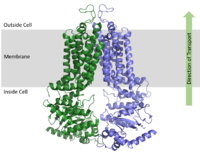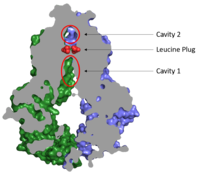Sandbox Reserved 1606
From Proteopedia
(Difference between revisions)
| Line 17: | Line 17: | ||
===Cavities and Leucine Plug=== | ===Cavities and Leucine Plug=== | ||
[[Image:Map_leucine_plug.png|200 px|right|thumb|Figure 2. Locations of Cavities 1 and 2 and the Leucine Plug in ABCG2. The above protein is in the inward-facing conformation]] | [[Image:Map_leucine_plug.png|200 px|right|thumb|Figure 2. Locations of Cavities 1 and 2 and the Leucine Plug in ABCG2. The above protein is in the inward-facing conformation]] | ||
| - | Substrates are transported through ABCG2 via two cavities separated by a leucine plug. <scene name='83/832932/Cavity_1_zoom_out/1'>Cavity 1</scene> acts as the multidrug binding pocket and is formed by helices at the interface of the subunits in the TMD. When ATP is not bound to the NBDs, Cavity 1 is <scene name='83/832932/Overall_structure_cavity_1hel/2'>open to the cytosol</scene> in order to recruit substrates for transport. Cavity 1 is full of nonpolar, hydrophobic residues and, as a result, prefers nonpolar, hydrophobic substrates, particularly polycyclic molecules.<ref name="Taylor"/> Substrates, such as estrone sulfate, <scene name='83/832932/Cavity_1_-_use2/2'>form hydrogen bonds and stacking interactions</scene> with residues from each subunit in Cavity 1. | + | Substrates are transported through ABCG2 via two cavities separated by a leucine plug. <scene name='83/832932/Cavity_1_zoom_out/1'>Cavity 1</scene> acts as the multidrug binding pocket and is formed by helices at the interface of the subunits in the TMD. When ATP is not bound to the NBDs, Cavity 1 is <scene name='83/832932/Overall_structure_cavity_1hel/2'>open to the cytosol</scene> in order to recruit substrates for transport. Cavity 1 is full of nonpolar, hydrophobic residues and, as a result, prefers nonpolar, hydrophobic substrates, particularly flat, polycyclic molecules.<ref name="Taylor"/> Substrates, such as estrone sulfate, <scene name='83/832932/Cavity_1_-_use2/2'>form hydrogen bonds and stacking interactions</scene> with residues from each subunit in Cavity 1. |
After substrates bind in Cavity 1, ATP binds each NBD leading to the shift from inward-facing to outward-facing. The outward-facing conformation results in the <scene name='83/832932/Atp_bound_cavity_2/2'>collapse of Cavity 1</scene> in the TMD. This collapse closes Cavity 1 to the cytosol and forces the substrate to move forward to Cavity 2 as there is no longer room in Cavity 1 to accommodate substrates.<ref name="Manolaridis"/> <scene name='83/832932/Atp_bound_use_cav_2/1'>Cavity 2</scene>, which is occluded when in the inward-facing conformation, is now open to the extracellular space and able to release the substrate. Cavity 2 contains a less hydrophobic environment and, as a result, substrates are released due to hydrophobic mismatch.<ref name="Taylor"/> <scene name='83/832932/Atp_bound_use_el_disulfides/1'>Disulfide bonds</scene> in the external loop near the exit of Cavity 2 also helps promote substrate release.<ref name="Manolaridis"/> Once Cavity 2 is empty, the protein can be converted to the inward-facing conformation via hydrolysis of ATP. | After substrates bind in Cavity 1, ATP binds each NBD leading to the shift from inward-facing to outward-facing. The outward-facing conformation results in the <scene name='83/832932/Atp_bound_cavity_2/2'>collapse of Cavity 1</scene> in the TMD. This collapse closes Cavity 1 to the cytosol and forces the substrate to move forward to Cavity 2 as there is no longer room in Cavity 1 to accommodate substrates.<ref name="Manolaridis"/> <scene name='83/832932/Atp_bound_use_cav_2/1'>Cavity 2</scene>, which is occluded when in the inward-facing conformation, is now open to the extracellular space and able to release the substrate. Cavity 2 contains a less hydrophobic environment and, as a result, substrates are released due to hydrophobic mismatch.<ref name="Taylor"/> <scene name='83/832932/Atp_bound_use_el_disulfides/1'>Disulfide bonds</scene> in the external loop near the exit of Cavity 2 also helps promote substrate release.<ref name="Manolaridis"/> Once Cavity 2 is empty, the protein can be converted to the inward-facing conformation via hydrolysis of ATP. | ||
| Line 24: | Line 24: | ||
==Disease== | ==Disease== | ||
| - | + | Dysfunctions in ABCG2 is linked to hyperuricemia which can lead to gout, kidney disease, and hypertension, all of which are thought to be the result of impaired transport of uric acid. | |
===Cancer=== | ===Cancer=== | ||
ABCG2 contributes to [https://en.wikipedia.org/wiki/Multiple_drug_resistance multidrug resistance] in cancer cells by exporting anti-tumor drugs out of cells which introduces an obstacle in cancer treatment.<ref name="Taylor"/> | ABCG2 contributes to [https://en.wikipedia.org/wiki/Multiple_drug_resistance multidrug resistance] in cancer cells by exporting anti-tumor drugs out of cells which introduces an obstacle in cancer treatment.<ref name="Taylor"/> | ||
Revision as of 17:15, 6 April 2020
| This Sandbox is Reserved from Jan 13 through September 1, 2020 for use in the course CH462 Biochemistry II taught by R. Jeremy Johnson at the Butler University, Indianapolis, USA. This reservation includes Sandbox Reserved 1598 through Sandbox Reserved 1627. |
To get started:
More help: Help:Editing |
ABCG2 Multidrug Transporter
| |||||||||||
References
- ↑ 1.0 1.1 1.2 1.3 1.4 1.5 Taylor NMI, Manolaridis I, Jackson SM, Kowal J, Stahlberg H, Locher KP. Structure of the human multidrug transporter ABCG2. Nature. 2017 Jun 22;546(7659):504-509. doi: 10.1038/nature22345. Epub 2017 May, 29. PMID:28554189 doi:http://dx.doi.org/10.1038/nature22345
- ↑ 2.0 2.1 2.2 2.3 2.4 2.5 Manolaridis I, Jackson SM, Taylor NMI, Kowal J, Stahlberg H, Locher KP. Cryo-EM structures of a human ABCG2 mutant trapped in ATP-bound and substrate-bound states. Nature. 2018 Nov;563(7731):426-430. doi: 10.1038/s41586-018-0680-3. Epub 2018 Nov, 7. PMID:30405239 doi:http://dx.doi.org/10.1038/s41586-018-0680-3
- ↑ 3.0 3.1 Robey RW, Pluchino KM, Hall MD, Fojo AT, Bates SE, Gottesman MM. Revisiting the role of ABC transporters in multidrug-resistant cancer. Nat Rev Cancer. 2018 Jul;18(7):452-464. doi: 10.1038/s41568-018-0005-8. PMID:29643473 doi:http://dx.doi.org/10.1038/s41568-018-0005-8
- ↑ Jackson SM, Manolaridis I, Kowal J, Zechner M, Taylor NMI, Bause M, Bauer S, Bartholomaeus R, Bernhardt G, Koenig B, Buschauer A, Stahlberg H, Altmann KH, Locher KP. Structural basis of small-molecule inhibition of human multidrug transporter ABCG2. Nat Struct Mol Biol. 2018 Apr;25(4):333-340. doi: 10.1038/s41594-018-0049-1. Epub, 2018 Apr 2. PMID:29610494 doi:http://dx.doi.org/10.1038/s41594-018-0049-1
Student Contributors
Julia Pomeroy


